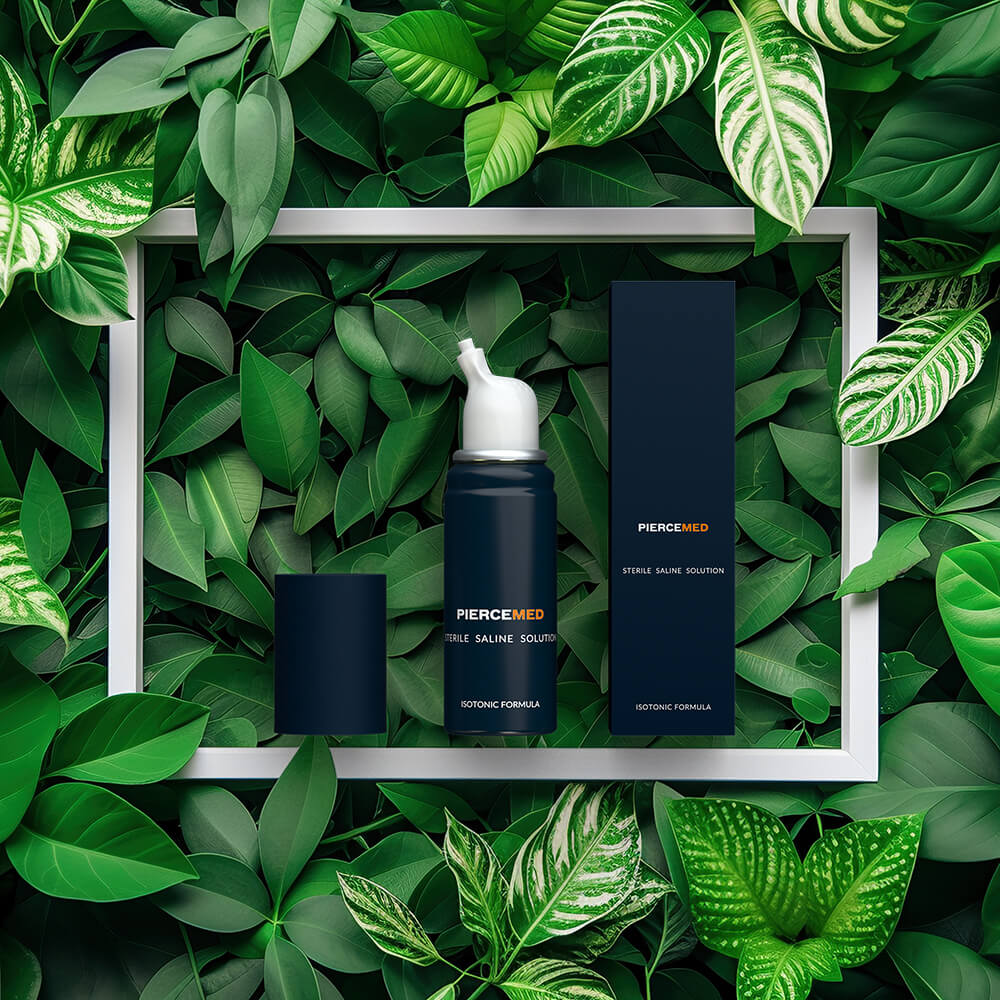7 PIERCING AFTERCARE MYTHS DEBUNKED
Piercings are a popular form of self expresion and fashion, with millions of people around the globe getting new piercings every year. However, despite its popularity, there is a lot of misinformation about the proper way to care for a new piercing. This article aims to debunk common myths about piercing aftercare and provide evidence-based advice to ensure your piercing heals beautifully and healthily.
MYTH 1: ALCOHOL OR HYDROGEN PEROXIDE IS BEST FOR CLEANING PIERCINGS
The Reality:
Alcohol and hydrogen peroxide are often mistakenly believed to be the best cleaning agents for new piercings. However, their harsh nature can cause significant damage to healing tissues, leading to irritation, delayed healing, and potential scarring.
Why:
These substances are highly astringent, stripping away not only harmful bacteria but also the beneficial ones that aid in the healing process. Moreover, they can dry out the skin, disrupting the delicate balance needed for wound healing. The Association of Professional Piercers (APP) recommends a gentle saline solution instead, as it effectively cleanses the area without the harsh effects, promoting a smoother healing journey.
MYTH 2: ANTIBIOTIC OINTMENTS SPEED UP HEALING
The Reality:
The use of antibiotic ointments like Germolene is a common but misguided practice. Rather than speeding up healing, these ointments can actually hinder it by trapping bacteria and disrupting the skin's natural breathing process.
Why:
Antibiotic ointments create a barrier over the piercing, preventing necessary air circulation. This environment can foster bacterial growth rather than prevent it. Furthermore, such ointments can cause allergic reactions or sensitivities in some individuals, complicating the healing process. Keeping the piercing clean and dry, allowing it to breathe, is the key to proper healing.
MYTH 3: ROTATING THE JEWELLERY PREVENTS IT FROM STICKING
The Reality:
Rotating jewellery in a healing piercing is outdated advice that can introduce bacteria and cause unnecessary irritation to the healing tissue.
Why:
The logic behind rotating jewellery was to prevent it from adhering to the skin during the healing process. However, modern understanding of wound care indicates that minimising disturbance to the healing area is crucial. Rotating the jewellery can tear at the healing tissue, setting back the healing process and potentially leading to infection or prolonged discomfort.
MYTH4: A PIERCING INFECTION CAN ALWAYS BE TREATED AT HOME
The Reality:
While minor irritations are common and can often be managed with proper aftercare, true infections are serious and require professional medical treatment.
Why:
An infection is characterised by symptoms such as severe redness, swelling, warmth, and pus, which are beyond the scope of basic aftercare practices. Attempting to treat a genuine infection at home can lead to worsening symptoms and potentially serious health complications. Professional evaluation and treatment, often involving antibiotics, are necessary to safely resolve an infection.
MYTH 5: THE TIGHTER THE JEWELLERY, THE BETTER
The Reality:
Jewellery that fits too tightly can restrict proper blood flow and lymph drainage, essential components of the healing process, leading to complications.
Why:
Tight jewellery not only causes discomfort but also can impede the natural swelling that occurs with a new piercing, potentially leading to embedded jewellery or other complications. Appropriate jewellery sizing accommodates swelling and allows for adequate air circulation, crucial for healthy healing. A professional piercer can ensure that the jewellery is of the correct size, neither too tight nor too loose, to support the healing process.
MYTH 6: I DON'T NEED TO DOWNSIZE MY JEWELLERY
The Reality:
Many believe that once jewellery is inserted, there's no need to change it unless for aesthetic reasons. However, downsizing your jewellery is an essential step in the healing process for many types of piercings, especially those in areas prone to swelling and movement.
Why:
Initially, piercers often use longer or larger jewellery to accommodate swelling. Once the initial swelling has decreased, continuing to wear jewellery that is too long or too large can cause issues. Excessively long bars or rings can catch on clothing or be subject to increased movement, both of which can irritate the piercing and lead to complications such as delayed healing, migration, or even rejection.
Downsizing to properly fitted jewellery reduces these risks by minimising movement and ensuring the piercing is less exposed to external stresses. This step is particularly crucial for piercings in areas of high mobility, such as the mouth (e.g., tongue piercings) or areas with tight clothing contact (e.g., navel piercings), and especially in cartilage piercings. Cartilage piercings are particularly susceptible to developing bumps and other healing issues due to their limited blood supply and the nature of cartilage tissue. Properly sized jewellery helps to mitigate these risks by stabilising the piercing and reducing the likelihood of irritation.
The ideal time to downsize can vary depending on the piercing location and individual healing rates. It's generally recommended to consult with your piercer about the best time to downsize, usually a few weeks after the initial piercing, once the swelling has substantially subsided.
Properly sized jewellery supports optimal healing by reducing trauma and irritation to the area, making downsizing an integral part of the piercing aftercare process. By acknowledging the importance of jewellery downsizing, you're taking a significant step towards ensuring the long-term health and appearance of your piercing.
MYTH 7: I CAN MAKE MY OWN SALINE SOLUTION
The Reality:
It's a common belief that one can easily create an appropriate saline solution at home for piercing aftercare. While homemade mixtures are possible, achieving the precise isotonic concentration of 0.9% salt, crucial for the ideal healing environment, presents a notable challenge.
Why:
A frequently recommended recipe for a homemade saline solution involves dissolving 1/4 teaspoon of non-iodized sea salt in one cup (8 ounces) of distilled or boiled water. However, this creates a solution with a salt concentration of about 0.6%, which is below the optimal 0.9% isotonic level. This difference is significant for several reasons:
- Optimal Healing Environment: An isotonic saline solution mimics the body's fluid composition, fostering an environment that supports natural healing without disturbing the cellular balance. A 0.6% solution, being slightly hypotonic, may alter this balance, potentially leading to cellular swelling and affecting the healing process.
- Comfort and Efficacy: Solutions that match the body's natural salinity (isotonic) are less likely to cause irritation or discomfort, ensuring the piercing site remains clean and conducive to healing. Deviating from this concentration can compromise comfort and the effectiveness of aftercare practices.
- Risk of Infection and Irritation: The precision of a 0.9% solution in preventing infection and minimising irritation is based on established medical practices. A less concentrated solution may not provide the same level of protection or support, increasing the potential for complications.
Given the importance of maintaining the best possible conditions for a new piercing to heal, using a commercially prepared isotonic saline solution is advised. These solutions are specifically designed to offer the correct concentration and sterility, eliminating guesswork and ensuring optimal care for your piercing. While homemade saline solutions can be used in a pinch, understanding the limitations and potential differences in healing outcomes is crucial.
CONCLUSION
In conclusion, navigating the sea of myths surrounding piercing aftercare can be daunting. From the misguided use of harsh cleaning agents to misunderstandings about jewellery downsizing, it's clear that well-intentioned advice can sometimes lead us astray. The key to a beautifully healed piercing lies not only in debunking these myths but in embracing evidence-based practices that support the body's natural healing processes.
Given the challenges and nuances in achieving the perfect isotonic saline solution at home, and the importance of precise aftercare to prevent infection and ensure optimal healing, turning to trusted products becomes essential. This is where PIERCEMED piercing aftercare solutions shine. Formulated to meet the specific needs of new piercings, PIERCEMED offers the ideal isotonic saline solution that mirrors the body's natural salinity, ensuring your piercing heals in the most conducive environment possible.
Choosing PIERCEMED for your piercing aftercare needs means opting for peace of mind. With its scientifically formulated solutions, you eliminate the guesswork and potential for error inherent in homemade aftercare methods. PIERCEMED's commitment to quality and piercing health makes it the go-to choice for those seeking the best in aftercare products. By selecting PIERCEMED, you're not just caring for your piercing; you're investing in its beauty, longevity, and overall health. Embrace the best practices in piercing aftercare with PIERCEMED, and enjoy the confidence that comes with knowing your piercing is in good hands.

PIERCING AFTERCARE
Create your business account today, and gain access to our exclusive piercing aftercare products.
DISCLAIMER: THIS ARTICLE DOES NOT CONTAIN ANY FORM OF MEDICAL ADVICE
The content of this of this article, including but not limited to text, graphics, images, and other materials, is strictly for informational purposes. Nothing on this article is meant to be a replacement for medical advice, diagnosis, or treatment from a medical professional.
Before beginning a new health care regimen or with any questions you may have about a medical condition or treatment, always consult a medical expert first.
Never disregard medical advice or put off consulting a medical professional because of something you have seen or read on this page.



